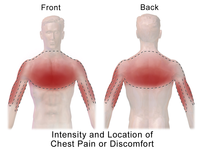
Photo from wikipedia
Background. Heavy truck drivers are exposed to various psychological, psychosocial and physiological factors, some of which can cause musculoskeletal discomfort in different body regions. Purpose. This study aims to investigate… Click to show full abstract
Background. Heavy truck drivers are exposed to various psychological, psychosocial and physiological factors, some of which can cause musculoskeletal discomfort in different body regions. Purpose. This study aims to investigate the correlation between different factors of musculoskeletal discomfort in heavy truck drivers. Methods. A cross-sectional study design was applied. A total of 384 participants were interviewed using an updated version of the Nordic musculoskeletal questionnaire. While hypothesis testing was used to assess the association of different factors in musculoskeletal discomfort, logistic regression was applied to explore different correlations among questions of the survey. Results. The results demonstrate that hours of exposure to vibration were associated with discomfort in the neck and shoulders (p < 0.001). This relationship was not statistically significant in the lower back area (p = 0.300). Additionally, 19 equations, their correlations and their odds ratios were formulated with Nagelkerke R2 > 0.05. Conclusion. Fifty-seven percent of the drivers were suffering from discomfort in their lower back region. Moreover, seat comfort was found to be highly correlated with discomfort in the neck, shoulder and upper back areas. Additionally, with aging the likelihood of experiencing discomfort in the neck, upper back and knees is increased.
Journal Title: International Journal of Occupational Safety and Ergonomics
Year Published: 2018
Link to full text (if available)
Share on Social Media: Sign Up to like & get
recommendations!